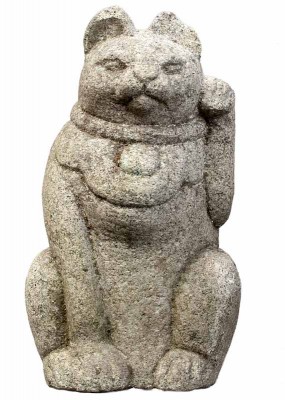 Those porcelain cat statues aren’t waving at you. They’re beckoning you to Bellevue for a lesson in Japanese culture.
Those porcelain cat statues aren’t waving at you. They’re beckoning you to Bellevue for a lesson in Japanese culture.
It’s hard to take cats seriously.
With the proliferation of LOLcats, Youtube videos of cat antics, and satirical books like the Oatmeal’s bestselling How to Tell If Your Cat is Plotting to Kill You, cats have become comical subjects, often portrayed as self-centered, mischievous and one paw ahead of the human beings that take care of them.
But cats have also been revered throughout history, valued for their poise, grace and their ability to kill rodents.
In Japan and China, cats are thought to bring luck, hence why many shops and homes display a maneki neko, a statue of a cat with one or both paws raised to attract wealth and general good fortune.

The Bellevue Arts Museum’s (BAM’s) current exhibit, “Maneki Neko: Japan’s Beckoning Cats—From Talisman to Pop Icon,” consists of more than 150 lucky cat statues and gives a historically rich view of these figures.
Originating in the Edo period, the maneki neko has many legends that reveal its beginnings.
One popular story involves a poor monk and a cat that lived in a decrepit temple in 1615. One day, a nobleman traveling from a hunting trip got caught in a storm and took shelter under a tree near the temple. The cat beckoned to him with one paw. As the nobleman followed the cat, the tree he was standing under was struck by lightning. The grateful nobleman credited the cat for saving his life and subsequently became the temple’s patron. After the cat died, maneki neko sculptures were made in its honor.
Dating from the 19th and 20th centuries, many of the ceramic, clay and porcelain cats in BAM’s exhibit are traced all the way back to the kilns where they were fired.
While they may seem similar, each cat bears distinctive features. Some are smiling; some, with wide yellow eyes, look surprised. Some wear a bell in the front, while others wear one to the side. Some cats are black, symbolizing safety, and were produced in kilns near Kyoto. Some are pristine and white, and hail from the Kutani kilns of Ishikawa Prefecture on the Sea of Japan coast. Some are red and sturdy and were made by potters working at the Bizen kiln, who used a dark and dense clay that required longer firing times.
Most of the statues are on loan from San Diego’s Mingei International Museum, and were donated by Billie Moffitt, a collector who was fascinated by the maneki neko. According to the accompanying book, Moffitt was not into cat art per se. It was specifically the maneki neko that interested her, and she went onto amass one of the most extensive collections in the world outside of Japan.
To round out the exhibit, BAM also invited ten Northwest artists, including Diem Chau, Saya Moriyasu, Yuki Nakamura, Maki Tamura and Patti Warashina, to give modern interpretations of the tradition.
A segment by Florangela Davila on the maneki neko exhibit from KCTS’s PIE.
Also showing at BAM is “Love Me Tender,” a surprising exhibit of art made with money. Bills and coins are painted, cut or molded into fabulous sculptures, tapestries and jewelry. Conceived by BAM Curator Nora Atkinson and Stefano Catalani, director of art, craft and design, the exhibit brings out conflicting emotions by both beautifying and debasing the almighty dollar.
Apropos of the conspicuous wealth of Bellevue, the exhibit should provide a thoughtful break for tech workers at nearby Microsoft and Expedia and shoppers at Neiman Marcus.
This story was originally published in the International Examiner.


